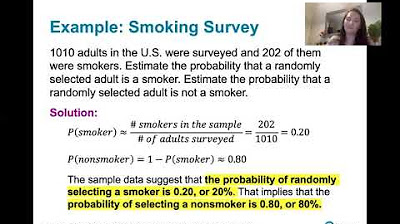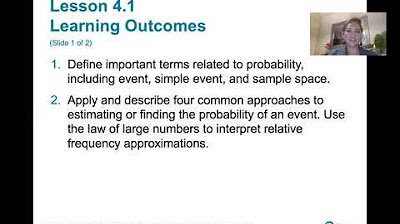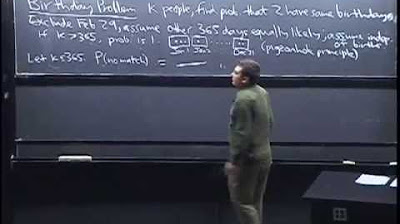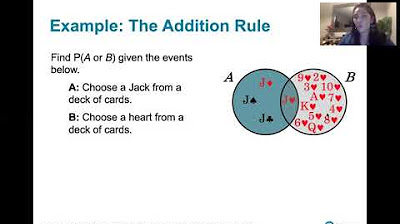4.2.4 Addition and Multiplication Rules - The Rule of Complementary Events
TLDRThis video lesson delves into the concept of complementary events, a fundamental principle in probability theory. It explains how the probability of an event and its complement must sum to one, using the addition rule. The video provides a clear example with a survey about smartphone users' annoyance with abbreviations, demonstrating how to calculate the probability of both the event and its complement, converting percentages to decimals for accurate representation.
Takeaways
- 📚 The video discusses the rule of complementary events from a lesson on probability.
- 🔍 Complementary events are mutually exclusive, meaning they cannot occur at the same time.
- 📉 The probability of an event (A) and its complement (not A) must sum up to 1, as one of them must occur.
- 📈 The script explains the addition rule, which is used to derive the rule of complementary events.
- 🌧️ An example is given where a 70% chance of rain implies a 30% chance of no rain, summing to 100%.
- 🔢 The script demonstrates converting percentages to probabilities, using the decimal form between 0 and 1.
- 📝 The rule of complementary events is presented in three different but equivalent formulas.
- 📉 The formula 'P(not A) = 1 - P(A)' is used to find the probability of an event not occurring.
- 📈 The formula 'P(A) = 1 - P(not A)' is used to find the probability of an event occurring.
- 📊 A real-world example is used to illustrate the rule, involving a survey about smartphone users and text abbreviations.
- 🤔 The video emphasizes the importance of translating probabilities into everyday language for better understanding.
Q & A
What is the main topic of the video?
-The main topic of the video is the understanding and application of the rule of complementary events in probability theory.
What is meant by 'complementary events' in the context of this video?
-Complementary events refer to two outcomes that cannot occur simultaneously, such as an event A and its complement, not A.
Why are complementary events considered disjoint?
-Complementary events are considered disjoint because they cannot occur at the same time; there is no overlap between the two events.
What is the probability of either event A occurring or not A occurring?
-The probability of either event A occurring or not A occurring is 1, as one of the two must happen.
How does the addition rule relate to the rule of complementary events?
-The addition rule is used to derive the rule of complementary events, by adding the probability of A and not A and considering their disjoint nature.
What is the mathematical formula for the rule of complementary events?
-The mathematical formula for the rule of complementary events is P(A) + P(not A) = 1, where P(A) is the probability of event A occurring and P(not A) is the probability of event A not occurring.
How can you rearrange the rule of complementary events to solve for the probability of not A?
-You can rearrange the rule of complementary events to solve for P(not A) by using the formula P(not A) = 1 - P(A).
What is an example of how the rule of complementary events can be applied?
-An example is given with a survey where 26% of respondents find abbreviations annoying. The rule is used to calculate the probability of selecting someone who finds abbreviations not annoying.
What is the probability of a smartphone user finding abbreviations annoying according to the survey?
-According to the survey, the probability of a smartphone user finding abbreviations annoying is 26%, or 0.26 when converted to a decimal.
How do you calculate the probability of a smartphone user not finding abbreviations annoying?
-To calculate the probability of a smartphone user not finding abbreviations annoying, you subtract the probability of them finding them annoying from 1, resulting in 1 - 0.26 = 0.74.
What is the significance of converting percentages to decimals in the context of probabilities?
-Converting percentages to decimals is significant because probabilities must be numbers between 0 and 1, which is the standard format for expressing probabilities in mathematical terms.
Outlines
📚 Understanding Complementary Events
This paragraph introduces learning outcome number four from lesson 4.2, focusing on the concept of complementary events in probability theory. It explains the rule of complementary events, which is derived from the addition rule. The speaker clarifies that the complement of an event (denoted as 'not A') is disjoint from the event itself, meaning they cannot occur simultaneously. The rule is illustrated with the example of rain probability, where the sum of the probabilities of rain and no rain equals one. The paragraph concludes with the formula for complementary events, showing how to calculate the probability of an event and its complement.
📉 Applying Complementary Events in Survey Analysis
The second paragraph applies the concept of complementary events to a real-world scenario involving a survey of smartphone users about text abbreviations. It demonstrates how to convert percentages into probabilities and calculate the probability of the complement event. The example uses a survey result where 26% of respondents find abbreviations annoying, thus the probability of this event is 0.26. The speaker then calculates the probability of the complement event—those who do not find abbreviations annoying—as 1 - 0.26, which equals 0.74. The paragraph emphasizes the importance of translating statistical findings into everyday language for better understanding, summarizing the probabilities in a way that is accessible to a general audience.
Mindmap
Keywords
💡Complementary Events
💡Addition Rule
💡Disjoint Events
💡Probability
💡Survey
💡Percentage Conversion
💡Abbreviations
💡Mutually Exclusive
💡Statistical Probability
💡Sample
💡Rule of Complementary Events
Highlights
The video discusses learning outcome number four from lesson 4.2 about understanding and applying the rule of complementary events.
The rule of complementary events relates to the addition rule in probability.
A bar denotes the event in which event A does not occur, also called 'not A'.
Events A and not A are disjoint because they cannot occur at the same time.
The probability that A occurs or not A occurs is always 1 since one of them must happen.
The rule of complementary events is derived by applying the addition rule and considering the disjoint nature of A and not A.
The probability of A occurring plus the probability of not A occurring equals 1.
The probability that A doesn't occur is 1 minus the probability that A occurs.
The probability that A occurs is 1 minus the probability that A doesn't occur.
An example is given using a survey about smartphone users' annoyance with abbreviations like 'lol'.
26% of respondents find such abbreviations annoying, which is converted to a decimal probability of 0.26.
The probability of selecting a user who finds abbreviations annoying is 0.26.
The probability of selecting a user who finds abbreviations not annoying is 1 minus 0.26, which equals 0.74.
The rule of complementary events is summarized in everyday language to make it understandable for anyone.
The lesson concludes by emphasizing that the probability of A occurring plus the probability of A not occurring must be 1.
Transcripts
Browse More Related Video

4.1.3 Basics of Probability - Finding the probability of the complement of an event

Multiplication & Addition Rule - Probability - Mutually Exclusive & Independent Events

4.1.0 Basics of Probability - Lesson Overview, Key Concepts and Learning Outcomes

Probability of Complementary Events & Sample Space

Lecture 3: Birthday Problem, Properties of Probability | Statistics 110

4.2.2 Addition and Multiplication Rules - The Addition Rule
5.0 / 5 (0 votes)
Thanks for rating: